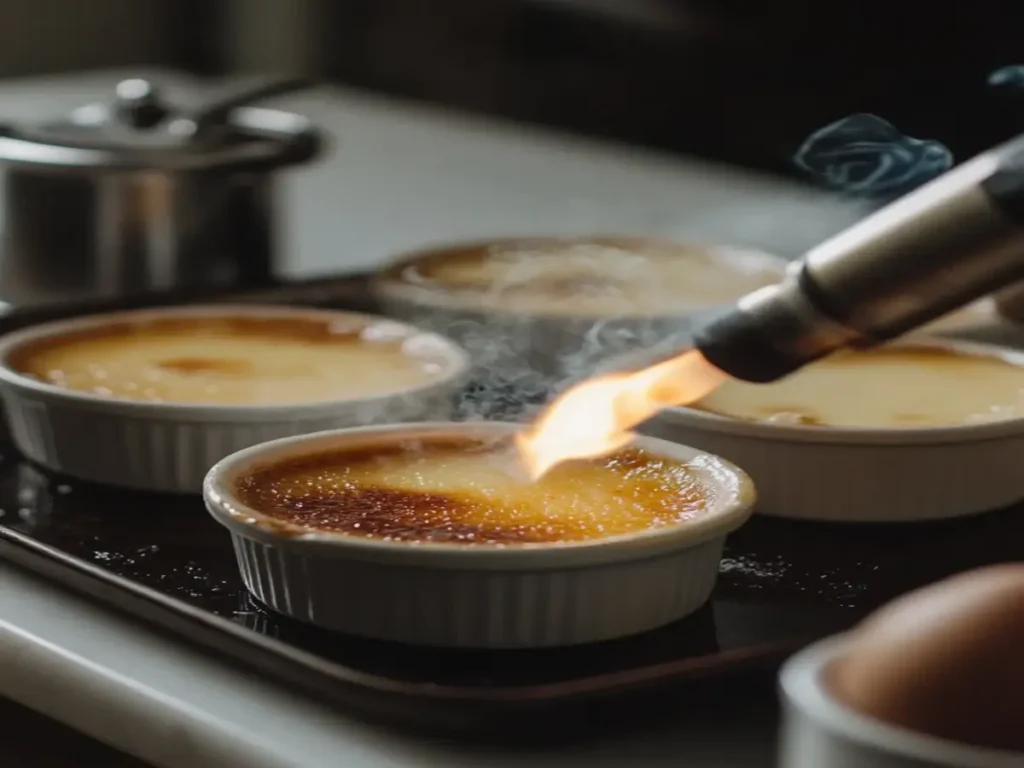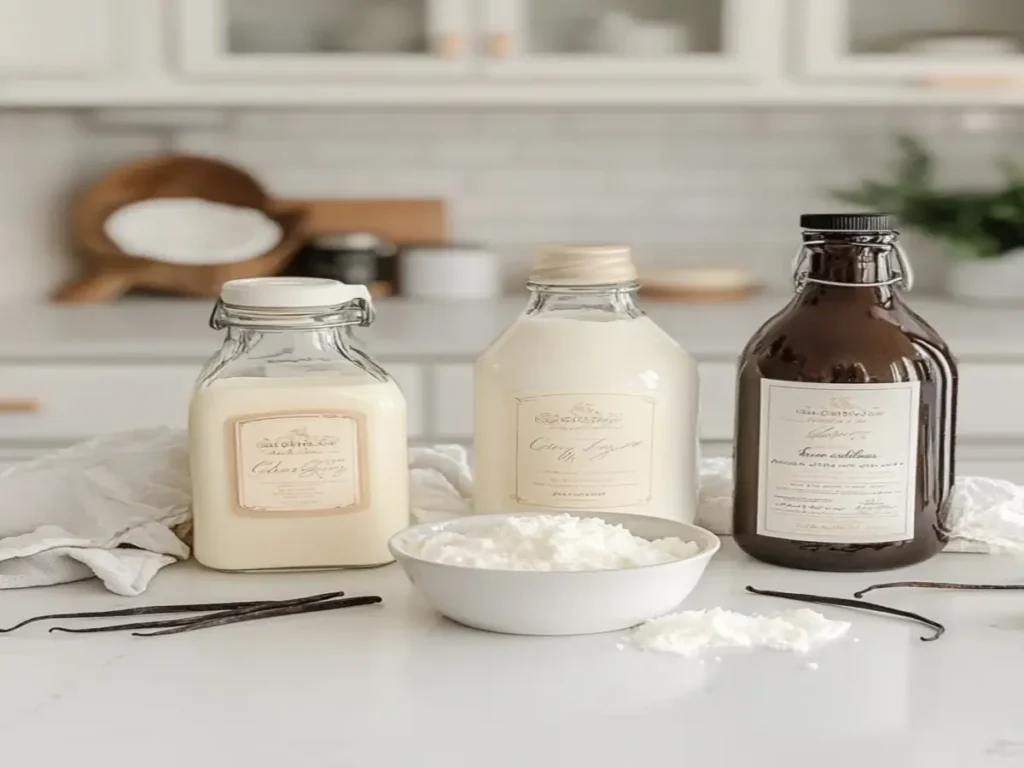Best Cream for Cream Brulee: Choosing the Right One for Perfect Texture
Cream brulee is more than just a dessert—it’s an experience. But did you know that the best cream for cream brulee can make or break its silky texture? The secret to achieving that signature custard lies in one crucial ingredient: the right cream.
If you’ve ever wondered which cream works best for this iconic dessert, you’re in the right place. From heavy cream to dairy-free alternatives, this guide breaks down the best cream options for crafting the perfect dessert. The choice of the right cream plays a crucial role in this dish, influencing everything from its velvety mouthfeel to its subtle richness. If you’re curious about the broader differences between cream brulee and custard, check out this comparison guide. In this article, we’ll uncover the best cream options for crafting the perfect cream , diving into the science and art behind this iconic dessert.
Table of Contents
Understanding Cream Brulee
What Is the Best Cream for Cream Brulee?
Cream brulee, which translates to “burnt cream” in French, is a dessert that has captivated palates worldwide. At its core, it’s a baked custard topped with a layer of caramelized sugar that’s torched to create a delightful crunch. The custard’s texture is incredibly smooth, a result of the perfect balance between cream, eggs, sugar, and vanilla.
What sets burnt cream apart from other custards is its contrast in textures. You’ve got the crisp sugar shell on top, which shatters beautifully with a spoon, and the luscious, creamy custard below. It’s this interplay that keeps people coming back for more.
The History of Cream Brulee
Cream brulee has a history as rich as its flavor. While it’s now considered a hallmark of French cuisine, its origins are debated. Some culinary historians trace its roots to a 17th-century English dish called “burnt cream,” while others argue that Spain’s crema catalana predates it. Despite the disagreements, it’s the French who truly popularized the dessert, cementing its place in fine dining.
Over the years, chefs have experimented with flavors and techniques, but one thing has remained constant: cream brulee’s reliance on high-quality cream to achieve its unmistakable texture and taste.
Want to learn the secret techniques behind a perfect burnt cream? Don’t miss this detailed guide on the secret to perfect burnt cream.
Essential Ingredients in Cream Brulée
While burnt cream might seem luxurious, its ingredient list is refreshingly simple:
- Cream: The star of the show, giving the custard its velvety texture.
- Egg Yolks: Responsible for thickening the custard and adding richness.
- Sugar: Used in the custard and for that iconic caramelized topping.
- Vanilla: Adds depth and warmth to the dessert’s flavor profile.
The role of cream, in particular, can’t be overstated. It’s what separates a good cream brulee from a great one. Using the wrong type or quality of cream can lead to a dessert that’s too runny, overly dense, or lacking in flavor.
Now that we’ve covered the basics of burnt cream, it’s time to explore why cream is such an essential ingredient in this dessert. From texture to flavor, cream does it all—let’s uncover the science behind its magic.
The Role of Cream in Cream Brulée
Why Heavy Cream is the Best Cream for Cream Brulee

When it comes to cream brulee, the cream isn’t just another ingredient—it’s the backbone of the dish. Cream is what gives the custard its rich, silky texture, which is why using the right type is absolutely essential. But why is cream so critical? Let’s break it down.
The cream provides the fat necessary to create a smooth and luxurious custard. Without enough fat, the dessert’s texture can turn out grainy or watery, far from the indulgent experience burnt cream is known for. It also contributes to the flavor, lending a subtle sweetness and richness that complements the vanilla and caramelized sugar.
In short, cream is the star player that ensures your cream brulee isn’t just a dessert, but a culinary masterpiece.
Comparing Cream with Other Dairy Options
Ever wondered if you could swap cream for milk or another dairy product in cream brulee? While technically possible, the results aren’t quite the same. Here’s how cream compares to other options:
- Milk: While milk can be used, it lacks the fat content needed for a velvety texture. burnt cream made with milk tends to be thinner and less satisfying.
- Half-and-Half: This mixture of milk and cream is a step up, but it still doesn’t offer the same richness as full cream. You might end up with a dessert that’s slightly watery or less indulgent.
- Non-Dairy Substitutes: Options like almond or coconut milk can work for plant-based versions, but they require additional adjustments to match the consistency and flavor of cream.
In a nutshell, nothing quite beats the original when it comes to cream brulee.
Ideal cream choices for cream brulee
Cream isn’t just about flavor—it’s about chemistry. The fat content in cream plays a pivotal role in how cream brulee sets during baking. Higher fat content means a firmer, smoother custard that doesn’t separate or curdle.
The ideal fat percentage for burnt cream is typically found in heavy cream, which contains around 36-40% fat. This level of fat ensures a custard that’s firm enough to hold its shape but soft enough to melt in your mouth. Lower-fat creams may cause the custard to break apart or develop an unappealing texture.
Which cream works best for this dessert
When shopping for cream, you’ll likely encounter terms like “light cream” and “heavy cream.” So, which one should you pick for your burnt cream?
- Light Cream: Contains 18-30% fat. While it can be used in a pinch, it won’t produce the same lush texture as heavy cream. The custard may also have a slightly diluted flavor.
- Heavy Cream: Contains 36-40% fat. This is the gold standard for cream brulee. It creates a custard that’s rich, smooth, and utterly decadent.
For the best results, stick to heavy cream. It’s the preferred choice of pastry chefs and home cooks alike for achieving that perfect burnt cream consistency.
Now that we’ve explored the science and importance of cream in cream brulee, it’s time to dive into the different types of cream available. Which ones work best, and are there any viable alternatives? Let’s find out.
Types of Cream for Cream Brulee
Heavy Cream: The Classic Choice
When it comes to making cream brulee, heavy cream is the gold standard. Why? Its high fat content (36-40%) makes it the ideal choice for creating that signature velvety texture and rich flavor. Heavy cream’s thick consistency ensures a custard that sets perfectly, providing the creamy mouthfeel that makes burnt cream so indulgent.
Another advantage of heavy cream is its neutral flavor. It allows the vanilla and caramelized sugar to shine while adding a subtle richness that complements the dessert’s overall profile. It’s no wonder that professional chefs and home bakers alike turn to heavy cream as their go-to choice.
If you’re aiming for a foolproof burnt cream that impresses every time, heavy cream should be at the top of your shopping list.
Alternatives to Heavy Cream

While heavy cream is the classic choice, there are alternatives that can work in certain scenarios. Let’s explore a few:
- Light Cream:
With a fat content of around 18-30%, light cream is a decent option if you’re looking for something less rich. However, the lower fat content may result in a slightly thinner custard, and the final dessert won’t have the same luxurious texture. - Double Cream:
Double cream, which boasts a fat content of 48%, is richer than heavy cream and popular in the UK. It can produce a thicker custard, but the extra fat might make the dessert overly dense. If using double cream, consider blending it with a small amount of milk to balance the texture. - Half-and-Half:
A mix of milk and cream with about 10-18% fat, half-and-half is not ideal for cream brulee. While it’s lighter, it lacks the richness needed for a proper custard, and the dessert may turn out watery.
Specialty Cream Options
For those seeking something unique, specialty cream options can add an extra layer of flavor or appeal:
- Organic Cream:
Organic cream is a fantastic choice if you value high-quality ingredients and sustainable farming practices. Many find that organic cream has a fresher, more pronounced flavor, which can subtly enhance the custard. - Flavored Creams:
Some brands offer creams infused with flavors like vanilla or caramel. While these can add convenience, be cautious with the flavor intensity—they might overshadow the delicate balance of the dessert.
Best Dairy-Free Cream Alternatives for Best Cream for Cream Brulee
What if you’re making cream brulee for someone who’s lactose-intolerant or vegan? Non-dairy substitutes can work, but they require careful adjustments.
Looking for a full recipe to try out your burnt cream skills? Follow this perfect cream brulee recipe for a step-by-step guide.
- Coconut Cream:
Coconut cream is the closest match to heavy cream in terms of consistency. It creates a custard that’s rich and smooth, with a mild coconut flavor. This can be a great option if the flavor complements your recipe. - Almond or Cashew Cream:
Nut-based creams offer a creamy texture but are lighter than coconut cream. They can work for a plant-based burnt cream, but you may need to experiment with ratios to get the right consistency. - Oat Cream:
Oat-based creams are gaining popularity as a dairy-free alternative. While not as rich as heavy cream, they can produce a decent custard when combined with additional thickeners.
Best Creams Available on the Market
If you’re wondering which brands to trust, here are some top options:
- For Heavy Cream: Look for trusted names like Horizon Organic, Land O’Lakes, or Trader Joe’s heavy cream.
- For Non-Dairy Options: Brands like Silk and So Delicious offer high-quality coconut and almond creams suitable for baking.
When choosing cream, focus on freshness and fat content. Check the label for additives like stabilizers, which can impact the custard’s texture.
With a better understanding of the cream options for cream brulee, you’re well-equipped to choose the perfect one for your dessert. Next, let’s wrap things up with a quick recap and answer some of the most common questions about cream brulee and its ingredients.
Conclusion
Making the perfect cream brulee isn’t just about technique—it’s about choosing the right ingredients, and cream takes center stage. Heavy cream remains the best option, thanks to its rich fat content and ability to create that signature silky texture. Whether you stick to the classic recipe or explore alternatives like light cream or non-dairy substitutes, the cream you use will define your dessert.
Remember, cream brulee is all about balance. By selecting the right cream and following the proper steps, you’ll be cracking into a dessert that’s every bit as luxurious as it looks. So, grab your torch, pick your cream, and get ready to wow your taste buds!
FAQs
Can I Use Milk Instead of the Best Cream for Cream Brulee?
While milk can be used, it isn’t the best option. The best cream for cream brulee has a high fat content (36-40%), which is essential for a rich, creamy texture. Using milk will result in a thinner, less indulgent custard.
Is Heavy Cream the Best Cream for Cream Brulee?
Yes! Heavy cream is the best cream for cream brulee because it contains 36-40% fat, creating a luxurious texture that holds its shape beautifully.
What’s the Best Fat Percentage for the Best Cream for Cream Brulee?
The best cream for cream brulee should have at least 36% fat, which is found in heavy cream. This ensures a smooth, rich custard with the perfect consistency.
